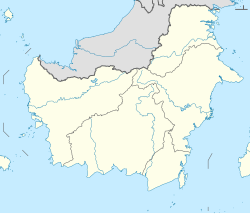Top Qs
Timeline
Chat
Perspective
Sepaku
District of Penajam North Paser Regency, East Kalimantan From Wikipedia, the free encyclopedia
Remove ads
Sepaku (Indonesian pronunciation: [səˈpaku]) is a district of Penajam North Paser Regency, East Kalimantan, Indonesia. As of 2024, it was inhabited by 41,677 people,[3] an increase from 40,322 people in 2023[4] and 39,738 people in 2022, and currently has the total area of 1,172.36 km2.[1] It was split off from Penajam on 11 June 1996.[5][6] Its district seat is located at the village of Tengin Baru.[1]
Sepaku is notable for being the site of the future national capital of Nusantara, although the local government claimed that only 10% to 20% of the current total area is being included.[7]
Remove ads
Etymology
According to the website of the Sukaraja village, Sepaku (and also the eponymous urban village of Sepaku) is named after the abundance of ferns (paku) in that district.[8][9]
History
Summarize
Perspective
Sepaku was originally inhabited by Balik people (a subgroup of Paser people), who migrated from neighbouring Balikpapan (Tanjung Gonggot).[10]
Before its establishment in its current form, Sepaku was known for being a destination for transmigrants, mostly of Javanese ethnicity,[11] with the land established in 1968 by a gubernatorial decree. Its settlement started on 26 August 1975 at the village of Sepaku I (now Bukit Raya), and ended in 1984 at Semoi III (now Sukomulyo). Along with Penajam (then known as Balikpapan Seberang), it was part of Balikpapan until 1987.[6] Another transmigration programs occurred in 1991 and 1998.[11]
On 11 June 1996, following the enactment of the government regulation number 38, Sepaku was formed from the northern parts of Penajam, along with the formation of 12 others in East and North Kalimantan.[5] Its formation was inaugurated on 25 September 1996 by then East Kalimantan governor H. Muhammad Ardans. On 5 March 1999, seven numbered villages were renamed by a gubernatorial decree, and only one (Semoi II or Semoi Dua) currently retains its name:[6]
- Sepaku I became Bukit Raya
- Sepaku II became Sukaraja
- Sepaku III became Tengin Baru
- Sepaku IV became Bumi Harapan
- Semoi I became Argomulyo
- Semoi III became Sukomulyo
- Semoi IV became Wonosari
Since 2002, Sepaku has been a part of Penajam North Paser (PPU), after it split from Paser Regency (then Pasir). Eight years later, on 14 April 2010, Binuang and Telemow villages were formed from parts of Maridan by local regulation number 6.[12][13] Before being chosen for the site of the future Indonesian capital in 2019, there had been demands from the district to secede from PPU due to lags in development.[14]
Remove ads
Geography
Sepaku shares borders with West Balikpapan (Balikpapan) to southeast; West Samboja, Loa Janan, and Loa Kulu (Kutai Kartanegara) to the east and the north; Bongan (West Kutai) to the northwest; Long Kali (Paser) to the southwest; and Penajam to the south. The average elevation in Sepaku is 15 meters above sea level.[15]
As of 2019, dozens of rivers were listed in Sepaku:[16]
Sepaku has been long prone to floods even before the establishment of Nusantara. As of mid 2023, 257 floods were recorded throughout 7 villages.[1]
Governance
Summarize
Perspective
Villages


Sepaku is divided into the following 15 villages (the rest are rural desa, and 4 of them are urban kelurahan, marked with grey background):[1][4]
District heads

The following are the list of district heads (camat) of Sepaku:[6]
Remove ads
Demographics
As of 2023, Sepaku was inhabited by 40,322 people (comprising 20,848 males and 19,474 females).[1]
Religion
As of 2023, by far the largest religious group in Sepaku were Muslims (36,461 people), followed by smaller minorities including Protestants (6,488 people), Catholics (1,007 people), Hindus (21 people) and Buddhists (8 people). Places of worships in Sepaku included 17 mosques, 30 small pray rooms (mushola), 24 Protestant churches, and a Catholic church.[4]
Remove ads
Education
As of 2022/2023 school year, Sepaku had 15 private kindergartens, 29 elementary schools (4 of them were private), 8 junior high schools (3 were private), a madrasah tsanawiyah (an Islamic counterpart of the former), 2 senior high schools (each private and public), and a private madrasah aliyah (an Islamic counterpart of the former).[4] Notable schools at Sepaku include:

- SD Negeri 020 Sepaku, which was relocated from its original flood-prone location, into a new building constructed by Astra Educational Foundation — Michael D. Ruslim.[17]
Remove ads
Health

As of 2022, Sepaku had 4 public health centers (puskesmas), 2 pharmacies, and each one hospital and polyclinic.[1] The first hospital at the district, Sepaku Regional Public Hospital, was inaugurated on 5 August 2021 by the regional secretary of PPU, Muliadi, and it began to provide health services on 10 January 2022.[18][19]
See also
- Nusantara, the newly-proposed capital of Indonesia, mostly located within Sepaku
References
Wikiwand - on
Seamless Wikipedia browsing. On steroids.
Remove ads





